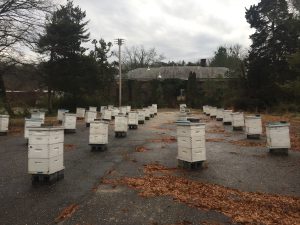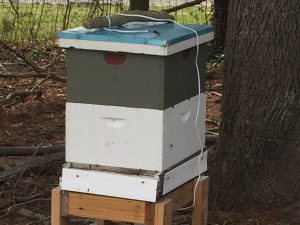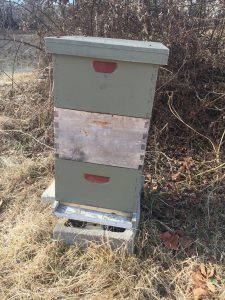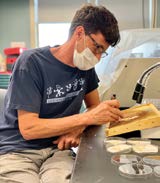Click Here if you listened. We’re trying to gauge interest so only one question is required; however, there is a spot for feedback!
Read along below!
Found in Translation
The Big Sleep
By: Jay Evans, USDA Beltsville Bee Lab
In most of the northern hemisphere, beekeepers have put their colonies to bed for the Winter and are eagerly anticipating their Spring awakening. Unfortunately, only two-thirds of colonies that go into Winter come out alive, leading to silent Springs for large and small beekeepers and impacting early pollination events. The only upside, for some, is a booming market for package bees and nucleus colonies. The causes of Winter losses are many, and determining which threats are most important is an active research topic.
This research takes three forms: 1) Direct experimental tests of potential killers, 2) Correlative studies of possible causes within and outside colonies and 3) for the extremely patient, long-term studies of Winter losses at the apiary or neighborhood level across different habitats. The ultimate goal of this research, and of beekeeper observations of their own losses, is to manage bees and their environment in healthier ways. A short-term goal, if less satisfying, is to simply have a better grasp of how many colonies will be on hand before making commitments to pollinate or placing early orders for new Spring bees.
 Experimental manipulations of colonies followed by a wait-and-see for Spring are challenging and expensive. To date, these experiments have pointed towards Varroa mite treatment as the single most important, and largely doable, management step needed to improve Winter survival, with nutrition, queen health and pesticide exposure all playing roles. These small-scale experiments are mirrored by insights from the Bee Informed Partnership’s Colony Management survey (www.beeinformed.org). Beekeepers remain the single most valuable player in maintaining colony health.
Experimental manipulations of colonies followed by a wait-and-see for Spring are challenging and expensive. To date, these experiments have pointed towards Varroa mite treatment as the single most important, and largely doable, management step needed to improve Winter survival, with nutrition, queen health and pesticide exposure all playing roles. These small-scale experiments are mirrored by insights from the Bee Informed Partnership’s Colony Management survey (www.beeinformed.org). Beekeepers remain the single most valuable player in maintaining colony health.
What about neighborhood or landscape causes for Winter losses? With increased tools for hive-monitoring tools and vital governmental resources for mapping reported land uses (e.g., the USDA’s Cropscape program, https://nassgeodata.gmu.edu/CropScape/), predicting landscape forces that sustain or kill bee colonies has become highly useful. I have highlighted the ‘Beescape’ project before (www.beescape.org), an effort to show beekeepers what is within foraging distance of their colonies. With parallels in other parts of the world, Beescape can guide apiary placement and nutrition management, and is also simply fascinating in a ‘Zillow’ sort of way in showing the best neighborhoods for raising bees. Land-use maps have been used to assess landscape features that favor bee health in habitats ranging from the western bee ‘breadbaskets’ to Philadelphia. As an example of the former, Dan Dixon at the University of North Dakota and colleagues from the U.S. Geological Survey mapped land use changes surrounding known apiaries across eastern North Dakota in Land conversion and pesticide use degrade forage areas for honey bees in America’s beekeeping epicenter (2021; PLoS One; https://doi.org/10.1371/journal.pone.0251043). They used this information to develop a ‘Quality Index’ for apiary sites, noting where colonies were likely to be exposed to insecticides and other threats and where they would be less vulnerable to those threats. As expected, areas with more natural forage, including those managed through the USDA’s Conservation Reserve Program, presented healthier forage options within reach of resident beehives. This recent work mirrors prior work in the same region, showing the importance of healthy forage for honey bee survival and honey production (i.e., recent work led by Autumn Smart from the University of Nebraska with the USGS team, Landscape characterization of floral resources for pollinators in the Prairie Pothole Region of the United States, 2021, Biodiversity and Conservation 30:1991-2015, https://digitalcommons.unl.edu/entomologyfacpub/949).
 Given the decent insights from experiments and landscape-level surveys, why would anyone wait on decades-long surveys to identify the causes of colony losses? First, these surveys are the best for showing changes in forage and climate over the long term. They also help separate threats beekeepers and bees can address from those they cannot. A brand-new 10-year survey from Germany points out some known risks while also finding a surprising twist. Jes Johannesen and colleagues, in Annual fluctuations in Winter colony losses of Apis mellifera L. are predicted by honey flow dynamics of the preceding year (2022, Insects 13, 829, https://doi.org/10.3390/insects13090829), merge hive monitoring and weather data with actual colony losses (as reported in surveys) to explore connections across years.
Given the decent insights from experiments and landscape-level surveys, why would anyone wait on decades-long surveys to identify the causes of colony losses? First, these surveys are the best for showing changes in forage and climate over the long term. They also help separate threats beekeepers and bees can address from those they cannot. A brand-new 10-year survey from Germany points out some known risks while also finding a surprising twist. Jes Johannesen and colleagues, in Annual fluctuations in Winter colony losses of Apis mellifera L. are predicted by honey flow dynamics of the preceding year (2022, Insects 13, 829, https://doi.org/10.3390/insects13090829), merge hive monitoring and weather data with actual colony losses (as reported in surveys) to explore connections across years.
 First, the authors make the case that management practices and bees are fairly homogenous, and hence variation in colony losses likely reflects climate or other environmental external variables. This is perhaps more true in Germany than in the U.S. Counter-intuitively, years in which bees started to return with forage sooner, i.e., ‘early Springs’, were linked with both larger colonies and heavier Winter losses the following Winter. This result likely reflects longer growing seasons for varroa mites and the delayed impacts of those mites. When ‘start date’ is factored out, colonies that gained weight the fastest in a three-month Spring flow had higher odds of surviving Winter, so colony growth itself remains a good predictor of colony futures. In a sign that local conditions are critical, colony losses in August correlated with losses the following Winter in the same apiaries. It would be nice to see disease data for these colonies; perhaps they had high virus, nosema or other loads that might have been a predictor of bad news by the following Spring, if not a trigger for disease control that Fall. The most surprising result involved year-to-year changes. Apiaries with low losses one year tended to have higher losses the next, and vice versa. Their best guess for a cause of this odd trend was that prior or alternate years might act as a purge for locally bad colonies, and the survivors would be, at least momentarily, over-achievers. Again, these surveys did not involve actual sampling, so it is hard to test that idea. I hope your own colonies fare well this Winter and are buzzing when you check them in 2023.
First, the authors make the case that management practices and bees are fairly homogenous, and hence variation in colony losses likely reflects climate or other environmental external variables. This is perhaps more true in Germany than in the U.S. Counter-intuitively, years in which bees started to return with forage sooner, i.e., ‘early Springs’, were linked with both larger colonies and heavier Winter losses the following Winter. This result likely reflects longer growing seasons for varroa mites and the delayed impacts of those mites. When ‘start date’ is factored out, colonies that gained weight the fastest in a three-month Spring flow had higher odds of surviving Winter, so colony growth itself remains a good predictor of colony futures. In a sign that local conditions are critical, colony losses in August correlated with losses the following Winter in the same apiaries. It would be nice to see disease data for these colonies; perhaps they had high virus, nosema or other loads that might have been a predictor of bad news by the following Spring, if not a trigger for disease control that Fall. The most surprising result involved year-to-year changes. Apiaries with low losses one year tended to have higher losses the next, and vice versa. Their best guess for a cause of this odd trend was that prior or alternate years might act as a purge for locally bad colonies, and the survivors would be, at least momentarily, over-achievers. Again, these surveys did not involve actual sampling, so it is hard to test that idea. I hope your own colonies fare well this Winter and are buzzing when you check them in 2023.









